

National Geographic. Core samples, tide gauge readings, and, most recently, satellite measurements tell us that over the past century, the Global Mean Sea Level (GMSL) has risen by 4 to 8 inches (10 to 20 centimeters).
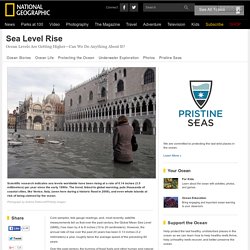
However, the annual rate of rise over the past 20 years has been 0.13 inches (3.2 millimeters) a year, roughly twice the average speed of the preceding 80 years. Over the past century, the burning of fossil fuels and other human and natural activities has released enormous amounts of heat-trapping gases into the atmosphere. These emissions have caused the Earth's surface temperature to rise, and the oceans absorb about 80 percent of this additional heat. The rise in sea levels is linked to three primary factors, all induced by this ongoing global climate change: Thermal expansion: When water heats up, it expands. Melting of glaciers and polar ice caps: Large ice formations, like glaciers and the polar ice caps, naturally melt back a bit each summer. Consequences How High Will It Go? 9 Classes of Dangerous Goods.
‘Dangerous goods’ are materials or items with hazardous properties which, if not properly controlled, present a potential hazard to human health and safety, infrastructure and/ or their means of transport.
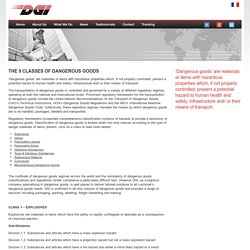
The transportation of dangerous goods is controlled and governed by a variety of different regulatory regimes, operating at both the national and international levels. Prominent regulatory frameworks for the transportation of dangerous goods include the United Nations Recommendations on the Transport of Dangerous Goods, ICAO’s Technical Instructions, IATA’s Dangerous Goods Regulations and the IMO’s International Maritime Dangerous Goods Code. Collectively, these regulatory regimes mandate the means by which dangerous goods are to be handled, packaged, labelled and transported. Regulatory frameworks incorporate comprehensive classification systems of hazards to provide a taxonomy of dangerous goods.
Sub-Divisions Division 1.1: Substances and articles which have a mass explosion hazard. The Big Thaw. Even in better times, the Chacaltaya ski area was no competition for Aspen.

Set in a bleak valley high in the Andes mountains of Bolivia, it offered a half-mile (one kilometer) swoop downhill, a precarious ride back up on a rope tow, and coca-leaf tea for altitude headaches. At 17,250 feet (5,260 meters), after all, Chacaltaya was the highest ski area in the world. “It gave us a lot of glory,” says Walter Laguna, the president of Bolivia’s mountain club. “We organized South American championships—with Chile, with Argentina, with Colombia.” The glory days are over. By last year all that remained were three patches of gritty ice, the largest just a couple of hundred yards (200 meters) across. USDOT Hazardous Materials Table 49CFR 172.101: Class 2 Compressed Gasses.
This page designed print cleanly without extraneous menus, ads, etc. and may make a great classroom handout.
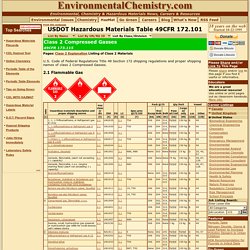
This page may benefit from setting your browser to print background colors. U.S. Code of Federal Regulations Title 49 Section 172 shipping regulations and proper shipping names of class 2 Compressed Gasses. Further notes are below. This data was compiled from the Hazardous Materials Table from the United States "Code of Federal Regulations" title 49 section 172.101. CLASS 2 - GASES. 2.2.
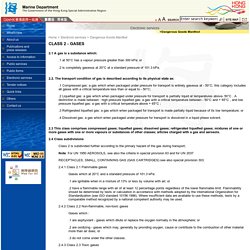
The transport condition of gas is described according to its physical state as: .1 Compressed gas: a gas which when packaged under pressure for transport is entirely gaseous at - 50°C; this category includes all gases with a critical temperature less than or equal to - 50°C; .2 Liquefied gas: a gas which when packaged under pressure for transport is partially liquid at temperatures above- 50°C . A distinction is made between : high pressure liquefied gas: a gas with a critical temperature between - 50°C and + 65°C , and low pressure liquefied gas: a gas with a critical temperature above + 65°C ; .3 Refrigerated liquefied gas: a gas which when packaged for transport is made partially liquid because of its low temperature; or.
Dangerous Goods Class 2 - Compressed Gas. HAZMAT Class 2 Gases. The HAZMAT Class 2 in United States law includes all gases which are compressed and stored for transportation.
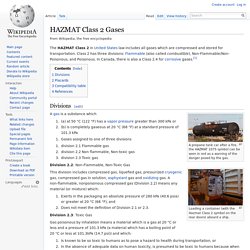
Class 2 has three divisions: Flammable (also called combustible), Non-Flammable/Non-Poisonous, and Poisonous. In Canada, there is also a Class 2.4 for corrosive gases.[1] Divisions[edit] USDOT HazMat Placards: Class 2 Compressed Gasses. This page designed print cleanly without extraneous menus, ads, etc. and may make a great classroom handout.
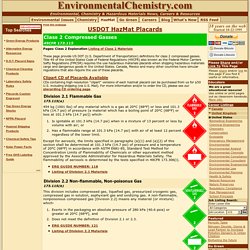
This page may benefit from setting your browser to print background colors. These page provide US DOT (U.S. Department of Transportation) definitions for class 2 compressed gasses. Title 49 of the United States Code of Federal Regulations (49CFR) also known as the Federal Motor Carriers Safty Regulations (FMCSR) requires the use hazardous materials placards when shipping hazardous materials cargo and dangerous goods in the United States. Canada, Mexico and many other countries have simular regulations that also require the use of these placards. Clipart CD of Placards Available.